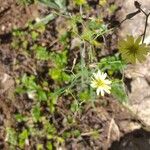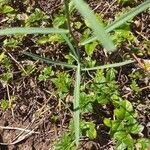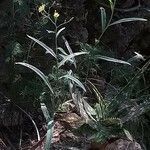Involucres 7–10 x 3–4 mm., not markedly accrescent, ovoid-cylindric, later spreading, glabrous, rarely shortly white puberulous outside; phyllaries 2–3-seriate, 2–4 mm. long and narrowly ovate on the outside, up to 7–10 mm. long and narrowly lanceolate on the inside, green and often reddish outside, sometimes subapically corniculate, midribs becoming swollen and corky below.
A herb. It keeps growing from year to year. It grows 100 cm high. It has a creeping root system. The stem is erect and hollow. The leaves at the base are in a ring. They are alternate on the stem. They are narrowly oval and 2-25 cm long by 1-8 cm wide. It can have lobes along the stalk. The flowers occur as 15-27 in a head.
Leaves sessile, mostly 5–10x1 cm., up to 25 x 3 cm. in well-grown plants, linear to narrowly elliptic, entire or with 1–3 pairs of lobes near the base, leaf and lobe apices acute, margins entire to acicular-denticulate, midrib prominent beneath; lobes 0.3–5.5 x 0.1–1 cm.
Achenes buff or pale-brown, 2.5–4 mm. long, subfusiform to narrowly obovoid, uniformly narrowly 6–14-ribbed, ribs muricate; pappus of white barbellate setae 4.5–5.5 mm. long, not exceeding the involucre.
Stem usually solitary up to 1.7 m. tall, hollow leafy and branched above, or sometimes divaricately branched from near the base; branches up to c. 50 cm. long.
Capitula numerous, in a lax ± diffusely branched panicle; capitula stalks up to c. 2.5 cm. long, with 0 to many reddish-tinged bracteoles.
Florets 10–25 per capitulum; corollas yellow, up to c. 11 mm. long, ligule often becoming reddish outside, 7–8 mm. long, lorate.
An erect glabrous long-lived annual herb, or perennial herb from a semi-woody rootstock.



